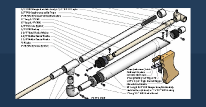Materials:
Plunger tube
Nylon plunger rod
Polycarb scraps for handle and plunger head
Skirt Plunger head
Bushing
[k26] spring
2 Standoffs
Great Stuff expanding foam
Misc:
Goop, e-tape, 1/2" screws (6-32), 4 washers, between 1.5 and 2" screw (6-32)
Copy/paste-able parts list for mcmaster
8585K431 1
8732K13 1
9562K46 1
91780A337 2
9637K26 1
Total Cost (each):
~$25, depending on how much you pay for polycarb scraps
Your first step is to cut your plunger tube to 9" in length. I recommend making a batch of these at a time because of the time requirements and the materials used (covered soon).

Next is the new method. Following the can's directions, shake the can of great stuff vigorously for 2 minutes or so. Put the dispensing nozzle on the tip. This stuff is one-time-use per can, and will last only as long as you're using it within 2 hour intervals. You'll want to be doing everything at once here.
Spray a layer of the foam on top of your plunger tubes. Try not to leave any gaps, but don't worry if you do. Set a timer for 40 minutes.

After your timer goes off, put another layer of foam on top of that one. Set your timer for 1 hour this time.

Once this timer is done, peel back any of the foam that dripped too far down. If you let it cure for too long, it won't come off cleanly. Now flip your plunger tubes over and foam up the first layer. Timer for 1 hour. Typically you'll want 3 layers total on this side, with an hour between layers.
Let these 5 layers cure overnight. Do not let them fully cure (24 hours). While they're in this in-between stage, the foam is soft on the inside. You should be cutting out the body now.
Take your foamed tubes to your band saw. Cut off the overflow on the ends, then the tops, making sure to make those cuts parallel. Finally, cut down the sides. You need these cuts to be at the sides of the plunger tubes. Your blade should be grazing the sides of the polycarbonate. Here's the cut progression:

After this, we can set up our cuts for the supports.

Draw a line to represent the top of the plunger tube. Draw a parallel line 1/2" above that. This will be your top - make it on thinner side.
Draw a line to represent the bottom of the plunger tube. Draw a parallel line 3/4" below that. Draw a vertical line 5.5" from the front of the plunger tube, and another vertical line 8" from the front of the plunger tube.
Cut along the bottom most line for the first 5.5", then cut 1/4" below the bottom of the plunger tube up to the 8" line. From there, cut out the corner.
While these are still soft, mark vertical lines on both sides at these points (distance from front of plunger tube): 4.25", 5", 6.75", 7.5"
Take a dremel with a boring bit (correct me if this name is inaccurate, this bit it used to cut channels normally) and cut out in between these sections over the distance where there is plunger tube. This is where the crossbow's internal supports go.
Once you have those done, fit your internals into your shell and mark where the decorative holes in the shell are onto the internals. Poke a screwdriver through these marks and insert your standoffs:

At this point, you can add your bushing with e-tape, goop and a screw. You can now leave these assembly to fully cure. The foam will harden around your standoffs, making them very sturdy.

While this is curing, cut your plunger rod to 12", with a notch 2-7/8" from one end (location is the back of the notch, where the catch meshes). Drill and tap both ends.
Cut your spring to 7" in length, cut a polycarbonate circle 1-1/8" in diameter with a 5/32" hole in center, 1/8" thick. Cut your priming handle of choice.
Finally, sandwich your skirt seal between the polycarb circle (front) and a 1-1/4" metal washer (back) onto the end of your plunger rod. Next put on your spring, then your catch, then your priming handle.
Once your plunger tube is cured, put lube (I recommend o-ring lube) in the plunger tube and insert your plunger assembly. All together:

When putting this into your shell, the front will have a gap. You may need longer screws in the screw ports - use 3/4" #6 wood screws. Use 6-32 screws with matching washers into the standoffs through the holes to distribute the load of firing and keep the shell together at the top.
All together:

This is the first crossbow to be able to use a hopper to break 100' ranges.
If you'd like, you can add extra layers of foam to create more features, such as this example grip for a missing-grip crossbow:

Special thanks goes to Muttonchops for letting me use his pristine crossbow to make these kits.
The 6 kits pictured here will be available for sale later today.
















